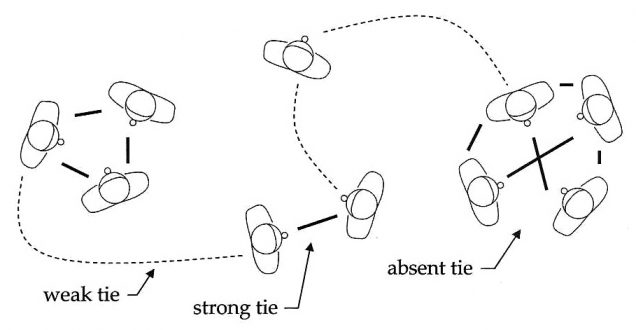The era of Internet redefines the social interaction. Beyond real-life social communication, the internet has generated virtual social circle that rivals the real social interaction. People who use ICT’s have broader and more diverse social networks than those who do not (Rainie & Wellman, 2012). A wide variety of social media platforms in ICTs allows people to connect with strangers who are thousands of miles away, anytime and anywhere. For sure, new technologies expand people’s social circles and people may have hundreds of friends online. Even though most of friends in the virtual social circle are strangers or unfamiliar friends, this kind of “weak tie” matters and the size of network matters.
Back to 1964, Marshall McLuhan proposed that media is the extension of man. The possibilities pioneered by technological advancement are widely affecting the rules of communication in human society. Nowadays, in the era of mobile Internet, more civic issues have been discussed in social media like Facebook and Twitter. People not only pay attention to their own living conditions, but also pay more attention to every individual in society. The forms of communication have been gradually changed, and weak social relationships have begun to occupy people’s social areas and change people’s social habits.
Corresponding to the strong relationship of frequent communication, weak relationship is the infrequent and even relatively unfamiliar interaction between people, which is the outer most layer of “social brain” as Robin Dunbar explained. It can’t be denied that people only have casual relationships with individuals inside of this layer. However, just because of the absent of sentiment, this kind of weak relationship has one special feature: high heterogeneity. The higher the heterogeneity of the individual’s social network, the higher the probability of ingesting social resources through weak relationships (Lin Nan, 2001). Due to the “shallow” social interaction, interacting with these people doesn’t need much time, but the sphere of communication is very wide, thus the information obtained can be various.
Let’s take a glance at the theory of strength of week ties. In 1973, Mark Granovetter advanced this theory and gave specific explanations. As he said, the strength of a tie is a combination of the amount of time, the emotional intensity, the intimacy (mutual confiding), and the reciprocal services which characterize the tie. And a given tie is strong, week or absent. From his perspective, the week tie is the local bridge and it can best achieve the transmission of a variety of information, allowing information flowing freely between different groups. And thus, people can get some important messages which can not obtained in their strong-related social circle by the bridge of week ties. Because the strong tie is existed in the small social group. The stronger the tie connecting two individuals, the more similar they are, in various way (Berscheid and Walster, 1969). So, the new information individuals can get from this inner social group is limited and repetitive relatively.

Week ties networking is a way of social interaction based on week ties. It only can be used when the development of social media is relatively mature. For a long time, we seem to get used to a “strong relationship” of interaction. And we are used to communicating, sharing information and asking for help with family, friends, colleagues, etc. Advances in technology give people more opportunities and channels to communicate with different people. The information searched through some social medias (such as Facebook, Twitter and Weibo) is often timely, novel and cross-class. Such messages are more valuable and can bring more and better knowledge expansion and experience accumulation. Besides, when a person wants to know the information from unfamiliar field, people from outer social group can be selected from the list in the social media and the message can be obtained relatively easily, like a job position in a company, and professional knowledge or skills. The medium is the message (Marshall McLuhan, 1964).

So does the network size matter? Based on the statements mentioned above, the answer is yes. We should take network size seriously and value the week ties. Even though human’s brain has the limited cognitive information-processing capacity, the bigger network size is, the more information we can get and the more entertainment we can have. The success of Facebook is one example of the strength of week ties. At present, most people who use the Facebook frequently have hundreds of friends. Why? People can add an unfamiliar person as a friend only because they are alumni or they come from same place even though they do not chat online after they become “friend”. Besides, some people’s image who have the same friend with you can automatically appear in your page. The reasons listed above are just the tip of the iceberg in Facebook’s operating mechanism. Just because of this pioneering operating mechanism of social interaction makes Facebook get ahead in the market.
In summery, the theory of the strength of week ties gives some inspiration that the essence of weak relationship socialization is the transmission of information between different social groups and continuous expansion of the circulation field. The size of network can extend our week ties and build more “bridges” in our social groups.
Reference:
Rainie, Lee., Wellman, Barry. (2012). Networked: The New Social Operating System. The MIT Press. Cambridge, Massachusetts.
Marshall, McLuhan. (1964). Understanding Media: The Extensions of Man. http://robynbacken.com/text/nw_research.pdf
Lin, Nan (2001). Social Capital: A Theory of Social Structure and Action. Cambridge: Cambridge University Press.
Berscheid, E., and E Walster. (1969). Interpersonal Attraction. Reading, Mass.: Addison-Wesley.
Mark, Granovetter. (1973). “The Strength of Weak Ties.” American Journal of Sociology 78: 1360-80.